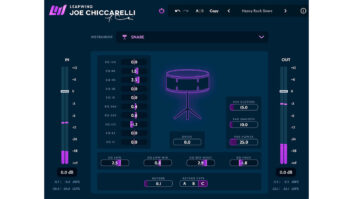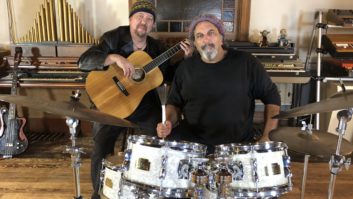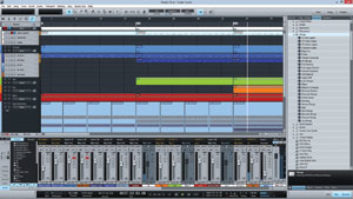You see plug-in versions of hardware products all the time, but it’s almost “man bites dog” for a company to come out with hardware versions of their software processors. Veteran plug-in developer Antares is one of just a couple of companies to have branched out this way.
Antares’ latest unit, the AVP-1 Vocal Producer, packs a large number of processes into a shallow, 1U enclosure: Antares’ mic and tube modeling, its famous Auto-Tune pitch correction, dynamics (variable-knee compression, downward expansion/gating/de-essing) and 2-band parametric EQ. You can use it live on a variety of instruments, and it’s particularly optimized for use as an insert device on vocals during mixdown.
HARDWARE
The single-channel AVP-1 is designed to work as an insert effect; thus, the mic preamp that is standard in conventional channel strips is replaced with ¼-inch unbalanced -10dBV, line-level I/Os. (Actually, its lack of provision for interfacing with +4 equipment can be an issue.) A second output, labeled Double Track, carries the dry signal when Auto-Tune is switched on in the main signal path, or an Auto-Tuned signal when the main signal isn’t being pitch-corrected.
Antares has done an excellent job of making the AVP-1 largely self-explanatory and easy to operate, with minimal button pushing and slogging through menus. Each process in the signal chain has a lighted on/off switch that is surrounded by from two to five parameter selection buttons.
A total of five 4- or 5-segment meters display input and output levels, gain reduction, pitch correction and de-essing. That’s in addition to the more refined metering that can be called up in the 2×20-character LCD, complete with a superimposed indication of the threshold setting when applicable.
MIDI I/O lets you store/retrieve presets, select program numbers and adjust a variety of parameters using assignable controllers. You can also use a footswitch to scroll through presets or bypass any number of processing sections (or the whole unit) with a single stomp. Real-time parameter changes using a MIDI controller are generally glitch-free.
In round numbers, the time through the unit is 6 ms with processing activated, and about 1 ms with it bypassed. You can always hear the effect of AD/DA conversion, but subjectively, it’s pretty benign in this case. Inherent noise was not a problem. Power is supplied by an external transformer.
MIC MODELER AND TUBE SATURATION
A few years ago, Antares had a product for Pro Tools called SST (Spectral-Shaping Tool) that would send out and record short bursts of noise, analyze the frequency content, and generate a FIR plug-in filter to compensate and/or copy the response and apply it to something else. Those algorithms are at the heart of Antares’ Mic Modeler.
Start by selecting the mic you’re using from a list of 20 choices, made up of several popular models and several generic descriptions (“large-diaphragm condenser,” “handheld dynamic,” etc.). The Mic Modeler uses this to apply an inverse frequency-response curve.
Then, select one of 10 target models. Unlike the plug-in versions of Mic Modeler, which have an ever-expanding list of downloadable source and target mic models, these are all unspecified descriptions on the AVP-1: A few different generic mic types, plus three drum mic settings (kick, snare, overhead — if you’re using a mono overhead) and “telephone.” There are settings for low-cut roll-off and proximity effect (specified in distance); the latter is very effective.
Mic Modeler doesn’t replace a collection of mics, but it certainly puts a lot of extremely interesting possibilities within easy reach. Most importantly, the mic models do their work without messing up the sound. The AVP-1’s generic descriptions of target mics set up a realistic expectation for what it can accomplish, although some of the plug-in version’s emulations aren’t half bad. There are people who say you can do the same thing with EQ, but this really has a different effect.
Next is the tube-saturation modeling, a very nice-sounding soft-distortion/transient-smoothing effect. Usually, a little bit goes a long way, but on one particularly gravely, hard rock, male vocal track, it sounded incredible turned all the way up.
PERFECT PITCH
Auto-Tune has become as common in studios as compression, so it needs no introduction. The AVP-1 (and the hardware ATR-1a) includes the plug-in version’s Auto mode, which works in real time.
There aren’t many settings required to make Auto-Tune work — you tell it what it’s looking at (instrument or vocal), the scale and retune speed. The latter is the most important parameter. At too fast a setting, it yanks the note into tune, eventually resulting in the Cher “Believe In My Vocoder” effect; set to too slow, you hear the note glide into tune.
It can help to ride the Speed and Bypass controls, which is where MIDI remote control can help. Another trick for way-off tracks is to run them through twice at conservative settings. If the overall pitch reference is off, then you can tune the output by a constant amount.
DYNAMICS, DE-ESSING AND EQ
Just recently, Antares’ JVP compressor may have been the only digital offering that could give you that loud, hard-limited, pumping, rock sound. You could — and can — also soften the knee and slow down the attack and release for a well-behaved and unobtrusive sound, but it was the fast attack/hard-knee/really fast release distorted sound that made it unique.
The AVP-1 version’s fastest release time is 20 ms, just fast enough to get you into trouble (in a good way). My first audition of the compressor was through the presets, and even in this instance, its prowess at smoothing out vocals without pumping impressed me. (Of course, all parameters can be tailored to your needs.)
It’s best to think of the downward expander/gate in this section as another set of controls over the dynamics curve rather than another processor in the chain. While this one isn’t intended to be a drum gate, it does a fine job of quieting down noisy input.
The de-esser in this unit is rather gentle. With an adjustable highpass filter in its sidechain rather than a notch (which would require a key listen feature), you’d have to work hard to mess up the sound. That comes at the price of reduced precision and range, but this comes as close as possible to the elusive auto setup de-esser.
The two bands of EQ are very flexible. Every EQ type is available (peaking, shelving, notch, etc.), and you can adjust everything — the slope of the shelves, the Q (.1 to 10) and so on. Not every frequency is available — for example, it jumps from 52 to 63 Hz — but each band covers the spectrum.
FINAL THOUGHTS
If you’re concerned that the AVP-1 is so inexpensive and does so much that there must be something wrong with it, don’t worry — Antares was simply able to pack a lot of their high-quality signal processing into this box. If the -10dBV, line-level hardware format fits your project studio, the AVP-1 covers a lot of ground.
Antares Audio Technologies, 231 Technology Circle, Scotts Valley, CA 95066; 831/461-7800; fax 831/461-7801; www.antarestech.com.
Nick Batzdorf was the editor of Recording for more than 10 years.





